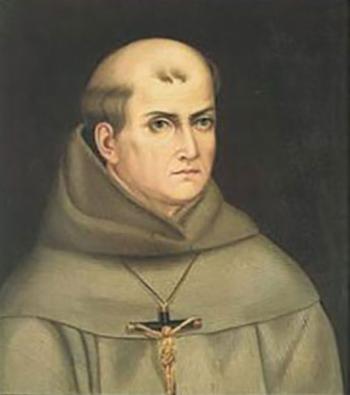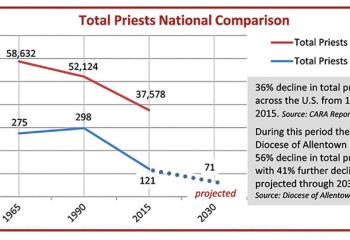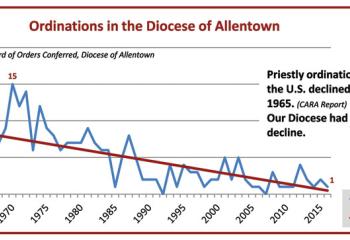In a series of meetings with all Diocesan priests over the summer, the Diocesan Office of Pastoral Planning shared data that shows the number of priests available to minister to the people of the Diocese has sharply declined over the years.
The priests were also shown projections that indicate the decline in the number of priests will worsen in the coming years. By the year 2030, the number of priests actively ministering in the Diocese is projected to be 71, down from 119 this year. That is a 40 percent decline in the number of active priests in the Diocese over the next 15 years.
The decline in the number of priests is not a problem unique to the Diocese of Allentown. According to data from the Center for Applied Research in the Apostolate (CARA) at Georgetown University, there was a 36 percent decline in the total number of priests in the United States between 1965 and 2015.
The projections made by the Diocesan Office of Pastoral Planning were based on a number of factors and assumptions. Among them: the age of the priests currently active in the Diocese and the fact that the normal retirement age for priests is 75.
Health concerns can lead to a priest retiring earlier than 75, and some priests remain in ministry past the usual retirement age. Among the priests active in the Diocese of Allentown today are nine men who are 75 or older, and four of them are over 80 years old.
Managing this decline will require new ways of deploying the priests who are active. Parish ministry will become the primary assignment for all Diocesan priests, and priests will be considered eligible for assignment as a pastor as early as five years after ordination, if not sooner.
Other measures that could be employed in the years to come include: recruitment of international priests and seminarians, and the withdrawal of priests from nonparish ministries such as education and health care.
Parishes that are currently served by a pastor and one or two assistant pastors will likely be served by a pastor alone, who may be responsible for multiple parishes.
Compounding the problem is that while the number of active priests has been declining, so has the number of new priests being ordained each year.
The largest ordination class in Diocesan history was 15 new priests in 1971. In the past 25 years, more than four men have been ordained in the same year only twice; it last happened in 2004. In the 13 years since then, only one priest has been ordained in seven of those years.
Currently there are 15 young men in seminaries studying to become a priest of the Diocese of Allentown.
In summary: Fewer priests + Fewer ordinations = a critical need for more vocations.
From the day of his appointment, Diocese of Allentown Bishop Alfred Schlert has identified the need for vocations as one of his highest priorities.
He invited his brother priests to help create a “Culture of Vocations” in the Diocese of Allentown. He noted the priests will need to be assisted by deacons, religious women and men, our seminarians, and in a very generous way by parents willing to encourage and support a vocation to the priesthood or religious life.
Fostering a culture of vocations must be the work of every parishioner, teacher, catechist and coach in the Diocese, the Bishop has said. According to Bishop Schlert, ensuring more priests will be among the primary tasks of the Diocese.
Serran Prayer for Vocations
O God, Who wills not the death of a sinner but rather that he be converted and live, grant we beseech you, through the intercession of the Blessed Mary ever Virgin, Saint Joseph, her spouse, Blessed Junipero Serra, and all the saints, an increase of laborers for your Church, fellow laborers with Christ to spend and consume themselves for souls through the same Jesus Christ, Your Son, Who lives and reigns with You, in the unity of the Holy Spirit, God forever and ever. Amen.










